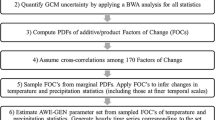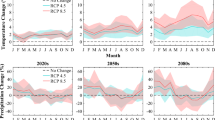Abstract
This study aims to examine how future climate, temperature and precipitation specifically, are expected to change under the A2, A1B, and B1 emission scenarios over the six states that make up the Southern Climate Impacts Planning Program (SCIPP): Oklahoma, Texas, Arkansas, Louisiana, Tennessee, and Mississippi. SCIPP is a member of the National Oceanic and Atmospheric Administration-funded Regional Integrated Sciences and Assessments network, a program which aims to better connect climate-related scientific research with in-the-field decision-making processes. The results of the study found that the average temperature over the study area is anticipated to increase by 1.7°C to 2.4°C in the twenty-first century based on the different emission scenarios with a rate of change that is more pronounced during the second half of the century. Summer and fall seasons are projected to have more significant temperature increases, while the northwestern portions of the region are projected to experience more significant increases than the Gulf coast region. Precipitation projections, conversely, do not exhibit a discernible upward or downward trend. Late twenty-first century exhibits slightly more precipitation than the early century, based on the A1B and B1 scenario, and fall and winter are projected to become wetter than the late twentieth century as a whole. Climate changes on the city level show that greater warming will happened in inland cities such as Oklahoma City and El Paso, and heavier precipitation in Nashville. These changes have profound implications for local water resources management as well as broader regional decision making. These results represent an initial phase of a broader study that is being undertaken to assist SCIPP regional and local water planning efforts in an effort to more closely link climate modeling to longer-term water resources management and to continue assessing climate change impacts on regional hazards management in the South.













Similar content being viewed by others
References
Edwards DC and McKee TB (1997) Characteristics of 20th century drought in the United States at multiple time scales. Climatology Report Number 97–2, Colorado State University, Fort Collins, Colorado
Felzer B, Heard PS (1999) Precipitation differences amongst GCMs used for the U.S. National Assessment. J Am Water Resour Assoc 35(6):1327–1339
Giorgi F et al. (2001) Regional climate information: Evaluation and projections, in Climate Change 2001: The Scientific Basis—Contribution of Working Group I to the Third IPCC Assessment Report, edited by J. T. Houghton et al., chap. 10, pp. 583–638, Cambridge Univ. Press, Cambridge, U.K
Hansen J, Russell G, Rind D, Stone P, Lacis A, Lebedeff S, Ruedy R, Travis L (1983) Efficient three-dimensional global models for climate studies: models I and II. M Wea Rev 111:609–662. doi:10.1175/1520-0493(1983) 111<0609:ETDGMF>2.0.CO;2
Hellmuth ME, Moorhead A, Thomson MC, and Williams J (eds) (2007) Climate Risk Management in Africa: Learning from Practice. International Research Institute for Climate and Society (IRI), Columbia University, New York, USA
IPCC (2001) In: Houghton JT, Ding Y, Griggs DJ, Noguer M, van der Linden PJ, Da X, Maskell K, Johnson CA (eds) Climate Change 2001: The Scientific Basis. Contribution of Working Group I to the Third Assessment Report of the Intergovernmental Panel on Climate Change. Cambridge University Press, Cambridge, United Kingdom and New York, NY, USA, p 881
IPCC (2007) Climate Change 2007: Synthesis Report. Contribution of Working Groups I, II and III to the Fourth Assessment Report of the Intergovernmental Panel on Climate Change, editied by Core Writing Team, Pachauri, R.K and Reisinger, A., 104 pp, Geneva, Switzerland
Karl TR, Trenberth KE (2003) Modern global climate change. Science 302:1719–1723
Karl TR, Melillo JM, Peterson TC (2009) Global climate change impacts in the United States. Cambridge University Press, New York
Kendall MG, Stuart A (1973) The advanced theory by statistics. Grinffin, London
Liang XZ, Pan J, Zhu J, Kunkel KE, Wang JXL, Dai A (2006) Regional climate model downscaling of the U.S. summer climate and future change. J Geophys Res 111:D10108. doi:10.1029/2005JD006685
Lo JCF, Yang ZL, Pielke RA Sr (2008) Assessment of three dynamical climate downscaling methods using the Weather Research and Forecasting (WRF) model. J Geophys Res 113:D09112. doi:10.1029/2007JD009216
Maurer EP, Brekke L, Pruitt T, Duffy PB (2007) Fine-resolution climate projections enhance regional climate change impact studies. Eos Trans AGU 88(47). doi:10.1029/2007EO470006
Mearns LO, Hulme M, Carter TR, Leemans R, Lal M, Whetton P, Hay L, Jones RN, Katz R, Kittel T, Smith J, Wilby R, Mata LJ, Zillman J (2001) In: Houghton JT, Ding Y, Griggs DJ, Noguer M, van der Linden PJ, Dai X, Maskell K, Johnson CA (eds) Climate Change 2001: The Scientific Basis. Contribution of Working Group I to the Third Assessment Report of the Intergovernmental Panel on Climate Change. Cambridge University Press, Cambridge, United Kingdom and New York, NY, USA, p 881, Climate Scenario Development
Mote P, Brekke L, Duffy PB, Maurer E (2011) Guidelines for constructing climate scenarios. Eos Transactions 92(31):257–258
Nakic’enovic’N et al (2000) Intergovernmental panel on climate change special report on emissions scenarios. Cambridge University Press, Cambridge, U.K
Nelson G et al (2009) Climate change: impact on agriculture and costs of adaptation. International Food Policy Research Institute, Washington, D.C
Pettitt A (1979) A nonparametric approach to the change-point problem. Applied Statistics 28:126–135
Piñol J, Terradas J, Lloret F (1998) Climate warming, wildfire hazard, and wildfire occurrence in coastal eastern Spain. Clim Chang 38:345–357
Santer B (2009), Climate scenarios 101: Which climate model is “best”, OCCRI Workshop on Scenarios of Future Climate, October 28–29, 2009, Portland
Schmidt GA, Ruedy R, Hansen JE, Aleinov I, Bell N, Bauer M, Bauer S, Cairns B, Canuto V, Cheng Y, Del Genio A, Faluvegi G, Friend AD, Hall TM, Hu Y, Kelley M, Kiang NY, Koch D, Lacis AA, Lerner J, Lo KK, Miller RL, Nazarenko L, Oinas V, Ja. Perlwitz, Ju. Perlwitz, Rind D, Romanou A, Russell GL, Mki. Sato, Shindell DT, Stone PH, Sun S, Tausnev N, Thresher D, Yao M-S (2006) Present day atmospheric simulations using GISS ModelE: comparison to in-situ, satellite and reanalysis data. J Climate 19:153–192. doi:10.1175/JCLI3612.1
Tapiador JF, Sanchez E (2007) Changes in the European precipitation climatologies as derived by an ensemble of regional models. J Climate 21:2540–2557. doi:10.1175/2007JCLI1867.1
Wilby RL, Wigley TML (1997) Downscaling general circulation model output: a review of methods and limitations. Prog Phys Geogr 21:530–548
Wilcox EM, Donner LJ (2007) The frequency of extreme rain events in satellite rain rate estimates and an atmospheric general circulation model. J Climate 20:53–69
Wood AW, Maurer EP, Kumar A, Lettenmaier DP (2002) Long-range experimental hydrologic forecasting for the eastern United States. J Geophysical Research-Atmospheres 107(D20):4429
Wood AW, Leung LR, Sridhar V, Lettenmaier DP, 62 (2004) Hydrologic implications of dynamical and statistical approaches to downscaling climate model outputs. Clim Chang 15:189–216
Acknowledgment
This research is funded by the Southern Climate Information Planning Program (SCIPP; http://www.southernclimate.org). We thank the National Weather Center for computing resources and acknowledge our colleagues in Hydrometeorology and Remote Sensing Lab (http://hydro.ou.edu) for their technical support. In addition, we acknowledge the modeling groups, the Program for Climate Model Diagnosis and Intercomparison (PCMDI), and the WCRP's Working Group on Coupled Modeling (WGCM) for their roles in making available the WCRP CMIP3 multi-model dataset. Support of this dataset is provided by the Office of Science, US Department of Energy.
Author information
Authors and Affiliations
Corresponding author
Rights and permissions
About this article
Cite this article
Liu, L., Hong, Y., Hocker, J.E. et al. Analyzing projected changes and trends of temperature and precipitation in the southern USA from 16 downscaled global climate models. Theor Appl Climatol 109, 345–360 (2012). https://doi.org/10.1007/s00704-011-0567-9
Received:
Accepted:
Published:
Issue Date:
DOI: https://doi.org/10.1007/s00704-011-0567-9




